South Dakota is a vast state with an extremely diverse landscape that is home to hundreds of species of birds, including 10 different woodpeckers. Whether you’re exploring the Black Hills, hiking the George S. Mickelson Trail, or just hanging out in Sioux Falls or Rapid City, there’s no doubt you can find a few woodpeckers hanging out.
Part of what makes hunting for these birds so fun is that they’re easy to identify. They have pretty distinct coloring and shapes, plus most of them peck into wood and trees, so they make a unique sound that you can identify from miles away.
If you’re ready to find some woodpeckers, pull out the binoculars, and let’s start the search.
Here is the list of species of woodpeckers in South Dakota:
- Downy Woodpecker
- Black-backed Woodpecker
- Hairy Woodpecker
- Northern Flicker
- Red-Headed Woodpecker
- Yellow-Bellied Sapsucker
- American Three-toed Woodpecker
- Red-bellied Woodpecker
- Lewis’s Woodpecker
- Red-Naped Sapsucker
10 Types of Woodpeckers in South Dakota
1. Downy Woodpecker
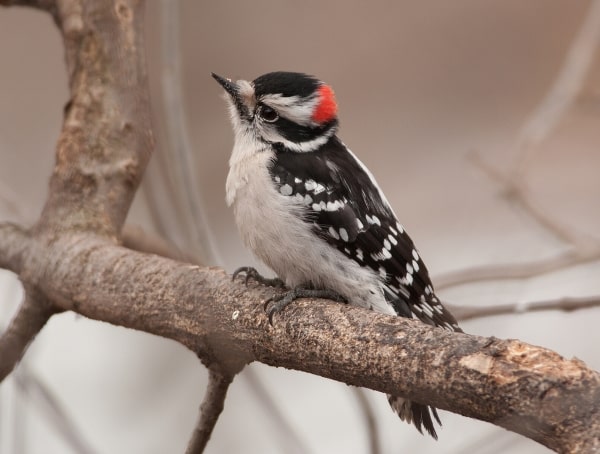
- Scientific name: Dryobates pubescens
- Size: 7 inches long
- Weight: 0.75-0.99 ounces
- Wingspan: 10-12 inches
The downy woodpecker is the smallest woodpecker in South Dakota, just the size of a chickadee. But its tiny size doesn’t make it difficult to spot. That’s because it’s brave and isn’t afraid to hang out around people if there’s good food around. It’s probably the most common woodpecker to see in all of South Dakota, so the chances are good that you’ll be able to find one.
This cute little bird doesn’t migrate. Instead, it stays in its home year-round, which means you can spot these woodpeckers even during the winter.
During the wintertime, they flock with other birds such as chickadees and nuthatches for safety and to find food. They build their nests in the cavity of trees where they live and raise their young. While they may change their habitat range during the seasons, they don’t travel too far.
You can find this itty-bitty bird woodpecker much anywhere. It lives in rural areas, cities, suburban yards, and wilderness areas.
Downy woodpeckers are black and white, with distinctly spotted wings and a white chest. Adult males have a bright red cap on the back of their heads, which makes them easy to identify from females.
If you want to see them without going out exploring, hang a suet feeder in your yard. They’re the most frequent visitor of suet feeders of all the different woodpeckers in South Dakota.
Because of their small size, they can land on small stems of plants to hunt for food. They’re also small enough that they often make nests in the wood siding of homes, much to the dismay of homeowners.
2. Black-backed Woodpecker
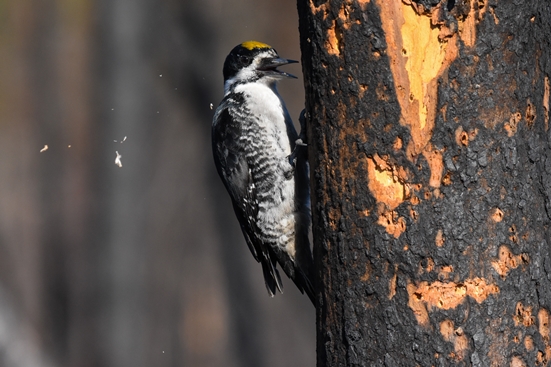
- Scientific name: Picoides arcticus
- Size: 9.1 inches
- Weight: 2.1-3.1 ounces
- Wingspan: 15.8-16.5 inches
Many woodpeckers in North America are some pattern of black and white, often with a red patch on the head. This woodpecker stands out because of its solid black back and white chest. It has a black face with a distinct white stripe. The male has a small yellow crown.
Making its home in burned-out forests across Canada and the western US, its black coloring helps it blend in with the charred trees that it hunts on. It eats beetle larvae and will hang out in recently-burned areas for several years before moving onto more newly burned areas.
It has been identified in South Dakota in just a few small areas in the southwestern part of the state.
3. Hairy Woodpecker

- Scientific name: Picoides villosus
- Size: 7.5 inches
- Weight: 1.4-3.4 ounces
- Wingspan: 13-16 inches
Hairy woodpeckers look a lot like downy woodpeckers, but they’re easy to tell from one another because Hairy woodpeckers are much larger. They also have longer bills, almost the same length as their head.
They’re black and white. You can tell the genders from one another because the adult males have a little red spot on the back of their heads.
These woodpeckers aren’t as common in South Dakota as their cousin, the downy woodpecker. That said, you can still see them in parks, suburban areas, cemeteries, and other quiet wooded or open areas if you’re patient. They also visit suet feeders in suburban backyards.
Like their cousin, hairy woodpeckers don’t migrate during the cold weather and stay in the same place all year. They make their homes in the cavities of dead trees.
Research published in The Journal of Wildlife Management found that they prefer forests that have been recently burned because there is abundant food for them there.
Populations have been declining in the past few decades because they’re losing their habitat. They also face pressure from invasive birds like European starlings, which steal their nesting spots.
4. Northern Flicker
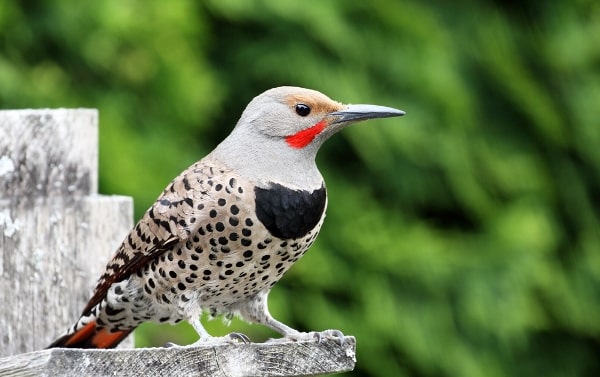
- Scientific name: Colaptes auratus
- Size: 11-12 inches
- Weight: 4-6.5 ounces
- Wingspan: 16.5-20 inches
The distinctive northern flicker woodpecker lives in open habitats near trees, as well as in parks and cemeteries across South Dakota. They are a frequent visitor to suet feeders in suburban and urban yards. Unlike some woodpeckers, they like to hunt around on the ground rather than in the trees.
They’re one of the most common woodpeckers in South Dakota, but they don’t all look the same.
The males, females, and juveniles vary in appearance depending on where they live. They’re brown overall, with black spots. The underside of the wings and tails are yellow in the eastern half of the US (like South Dakota) and red in the western half of the US. These are the second largest woodpeckers in South Dakota.
Some have a red or black stripe on their cheeks, and many of them have large, black crescents on their chest. Others have red marks on the back of the head. Some have a slightly gray head.
You can hear the calls of Northern flickers for a long way off during the spring mating season. They have an extremely distinct call, and once you know what it sounds like, it’s easy to tell when they’re nearby.
They primarily eat ants, but they’ll also feast on other insects such as caterpillars, beetles, and termites. This is definitely a bird you want to have around! There are also instances of them catching young bats as they leave the nest. You can tempt them to visit your home by offering a suet feeder in the yard.
Flickers who live in northern climates like Alaska and Canada will migrate to places with warmer temperatures during the winter, but these woodpeckers stick around South Dakota all year round.
Studies show that Northern Flickers can lose their nests to invasive species like European starlings.
5. Red-headed Woodpecker
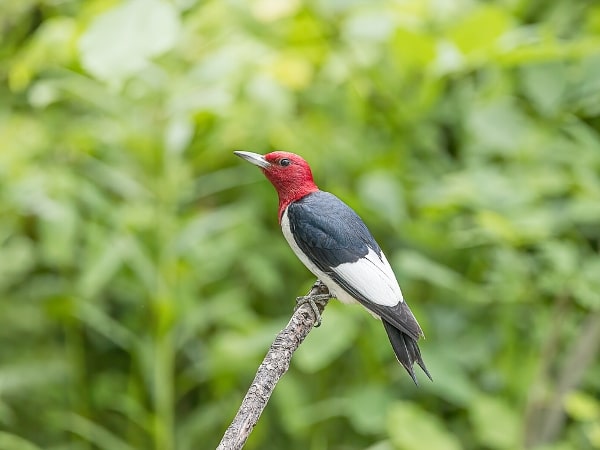
- Scientific name: Melanerpes erythrocephalus
- Size: 7.5-9.1 inches
- Weight: 2.0-3.2 ounces
- Wingspan: 16.5 inches
Red-headed woodpeckers are striking. They have solid black wings with a big white patch and white bodies. To top it off, they have a dark red head and neck that is so vibrant it looks like velvet.
The juveniles are brownish-black with white spots on the wings and pale red cheeks.
They don’t cross to the west side of the Rocky Mountains, but they can be found in all parts east, from Canada to Florida. These woodpeckers live in South Dakota during the breeding season. You can entice them to your yard during the winter by offering them some citrus or suet.
It’s one of the few woodpeckers out there that store food for the winter. They stuff seeds and nuts in bark or holes in trees. They have even been known to stuff food under shingles; a practice homeowners aren’t fond of.
They also hunt their prey, snatching insects out of the air as they fly. That’s unusual behavior for woodpeckers.
6. Yellow-bellied Sapsucker
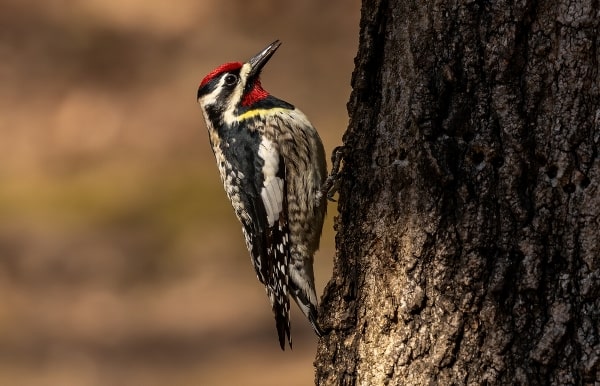
- Scientific name: Sphyrapicus varius
- Size: 7.1-8.7 inches
- Weight: 1.5-1.9 ounces
- Wingspan: 13.4-15.8 inches
The yellow-bellied sapsucker lives in the eastern half of the US and heads to the southern part of the country in the winter. They migrate through the eastern part of South Dakota but they don’t live there.
These birds are primarily black and white, with white bellies and black and white barred wings and back. You can tell the difference between males and females because the male’s throat is bright red. Females, on the other hand, have a white throat. Both the females and males have red foreheads.
The females have a faint yellow coloring on their bellies, but it can be so indistinct that you might not be able to identify it unless you get close–which they definitely won’t let happen. They’re very cautious of humans.
These sapsuckers drill tiny holes into trees with their beaks, and then they wait for the sweet sap to leak out. They lick this up, along with any insects that crawl along and get stuck in the fluid.
You might see them hanging out at your backyard suet feeder, but they mostly stick to forested areas. They aren’t nearly as bold as some of their woodpecker cousins.
7. American Three-Toed Woodpecker

- Scientific name: Picoides dorsalis
- Size: 8.3-9.1 inches
- Weight: 1.6-2.4 ounces
- Wingspan: 14.6-15.3 inches
This woodpecker primarily makes Canada its home, but you will rarely see it pop down to North Dakota, Michigan, and Maine. It also lives year-round in western parts of the country, including Idaho, Utah, Colorado, and Wyoming. It has been definitively identified in South Dakota in just a tiny part of the southwest corner of the state.
This bird likes to hunt in burned-out areas and forests where beetles have killed lots of trees. It hunts for insects, pulling and stripping away bark until it finds what it is looking for.
Yes, this bird only has three toes, but you’ll most easily be able to identify it by its coloring. It’s primarily black, but it does have white barring on its sides and back, and the chest is white. The male has a bright yellow crown.
8. Red-bellied Woodpecker
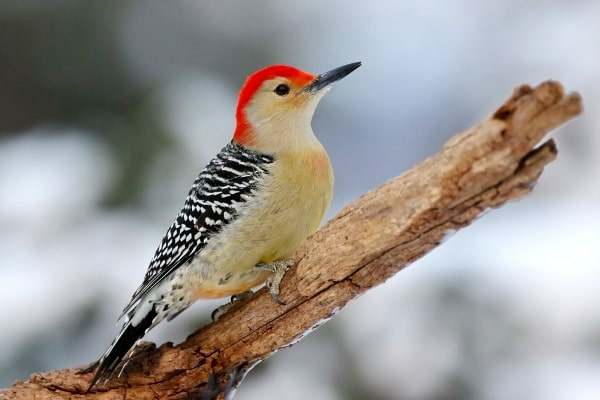
- Scientific name: Melanerpes carolinus
- Size: 9.5 inches
- Weight: 2.0-3.2 ounces
- Wingspan: 13.0-16.5 inches
You’d probably expect these woodpeckers to have bright red bellies, but that’s not the case. Typically, their bellies are creamy white. Their back and wing feathers are black and white striped, and the females have a red nape. The males have a red nape and crown.
So, where did the name come from? The woodpeckers do have red feathers on their bellies, but they’re covered by white feathers, so you can’t actually see them.
These active birds live all across the Eastern United States, and you can spot them in the air as they fly by their undulating flight pattern. They live in South Dakota year-round, but only in the southeastern corner of the state.
Look for them in oak and hickory trees, where they like to feed and nest. They’ll also pop up at suet feeders now and then.
9. Lewis’s Woodpecker
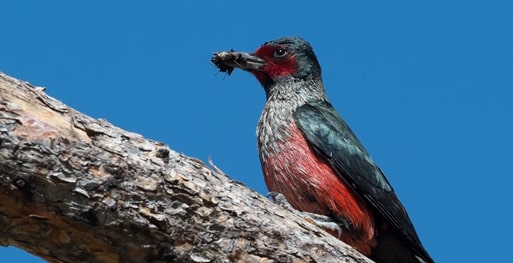
- Scientific name: Melanerpes lewis
- Size: 10.2-11 inches
- Weight: 3.1-4.9 ounces
- Wingspan: 19-.20.5 inches
This medium-sized bird typically lives across the western half of the US, migrating from the northern part of the country to the southern part during the winter. However, when they’re breeding in the spring, you might spot them in the western edge of South Dakota.
They don’t dig or peck into trees as most other woodpeckers do. Instead, they hunt for insects crawling around on the bark.
These lovely woodpeckers stand out with their green and pink feathers, red faces, and white necks. They also like to catch insects mid-air while flying, which sets them apart from other birds. That’s something most woodpeckers don’t do, for the most part.
As fall comes around, this industrious bird collects acorns and other nuts and stuffs them into cavities in trees so that they have food for later.
Pairs mate for life and make nests in excavated trees or utility poles.
10. Red-naped Sapsucker
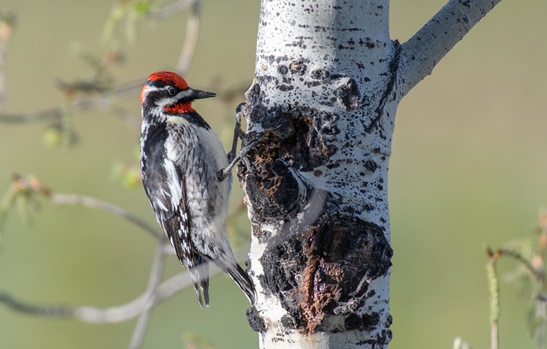
- Scientific name: Sphyrapicus nuchalis
- Size: 7.5-8.3
- Weight: 1.1-2.3 ounces
- Wingspan: 16-16.9 inches
As the name suggests, this bird has a thing for the sap in trees. It will tap little holes into the bark so that sugary sap runs out and it can eat it.
They particularly love aspen, pine, and birch trees. They’ll even nest in backyards that have those trees, and they will stop and visit if you provide them with a suet feeder. You can find this woodpecker only on the western edge of South Dakota and only during the breeding season.
These sapsuckers have vertical white patches that you can only see when the wing is folded. They have black and white striped bodies and heads, and a bright red cap and throat, though some females have a white throat.
This is a close relative of the red-bellied sapsucker and the yellow-bellied sapsucker. They all look fairly similar.
Also Read: Owls in South Dakota
